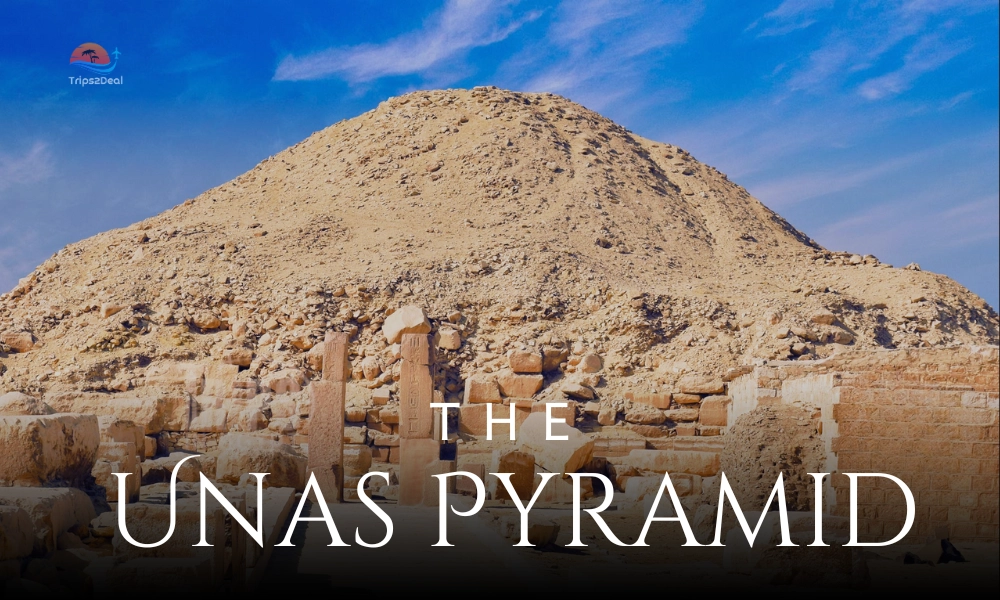Blogs

Unas Pyramid
One of the most important buildings belonging to the old Kingdom in Egypt and more precisely the Fifth Dynasty is the Pyramid of Unas situated at Saqqara in Egypt. It was built during the reign of Pharaoh Unas, who reigned between 2375 and 2345 BCE, and is mostly famous due to the reminders present in its chambers, which give us a priceless insight into the practice of the Egyptian religion and the developing culture of pyramid writing. This article discusses the history, design and culture of the Pyramid of Unas.
Table of Contents
Historical Context
Egyptian culture and politics were altered by the Fifth Dynasty with Unas. This is the royal interest in religious activities and pyramid complexes to adorn the royal funerary cult. The final pharaoh of this dynasty, Unas, commissioned a pyramid, which was to be his tomb and the representation of the changes in the position of the pharaoh as a god-like ruler and connector between deities and people.
The era of Unas was critical. His pyramid joined the fashion of incredibly monumental royal tombs. Although the pyramid is smaller than the Great Pyramid of Giza built under the Fourth Dynasty, it established some important standards to be followed in pyramid construction especially with the embedding of scriptures that would guarantee post-death safety of the king.

Architectural Features of the Pyramid
Comparing Little Unas pyramid with pyramids of IV dynasty. This was elevated 43 meters (141 feet) wide and 57 meters (187 feet) high. The casing of the pyramid in limestone is mostly gone. It is significant in architecture and yet minute like such as.
- The pyramid is a step pyramid just like the others but it terminates the era. In case of Unas, the pyramid was stepped in contrast to later ones. The pyramid was constructed using limestone that made the sides of the pyramid reflect sunlight and bring the king higher.
- Pyramids built in this period had causeways and funerary temples such as Unas. Offerings and rituals at the mortuary temple using the north side of the pyramid kept the spirit of the king fed. There was a causeway linking a funerary temple with a monarchy temple in the valley.
- Unas sarcophagus was in the pyramid burial room. There are reliefs/inscriptions painted on a small room. Enter the pyramids heart in order to get to the afterlife burial room.
- The strong point of the Pyramid of Unas is the texts. Egyptian funerary literature was affected by writings in the oldest religion of the world. Charms, prayers, and hymns in books are present to defend and revive the pharaoh.

The Pyramid Texts: Religious Significance
Egypt's Pyramid Texts in Unas are religious and cultural. The first royal tomb religious texts are fundamental to Egyptian belief. The Pyramid Texts promised ritual magic and divine protection to overcome the pharaoh's afterlife difficulties.
Texts chronicle the pharaoh's divinization. They highlight the king's marriage to Ra and paradise ascension. The Pyramid Texts cover resurrection and guide the pharaoh's ka through the afterlife. Osiris and Ra, who will resurrect the king, are discussed.
Religious writing and ceremonies gained importance in the Old Kingdom, as shown by pyramid texts. On Unas' pyramid concepts, the Coffin Texts and Egyptian Book of the Dead emerged. The Pyramid Texts characterize the pharaoh as a political ruler and divine conduit who preserved cosmic order.

The Decline and Legacy of the Pyramid of Unas
Like other pyramids in the Old Kingdom, the Pyramid of Unas degenerated. Their burial chamber was looted and its casing shaft of limestone has been taken away. These damages do not render the pyramid as not being a site of archeological and historical interest. The inscriptions on the pyramids unveil religious traditions and the change in the Fourth Dynasty royal funerary traditions to the one of the Fifth Dynasty.
The Pyramid of Unas introduced the royal burials structure in the Middle Kingdom. Other tombs had Pyramid Texts and these developed to become more complex such as the Coffin texts/symbols and Book of the Dead.
Besides being religiously important, Pyramid of Unas demonstrates the architecture of the Old Kingdom. It is smaller and less luxurious than other pyramids contemporary to it, nevertheless, it signifies the last period of pyramid building preceding the Middle Kingdom where the tombs became larger and incorporated religious text.
Conclusion
The Pyramid of Unas, which is probably the most significant Old Kingdom monument, exposes the ancient Egyptian religion and architecture. The pyramid is a representation of how the royal tombs expanded during this period, even though it is small. The Pyramid Texts focus on theological reflection concerning life in the next world and the godhead of the pharaoh. The longstanding history and enduring effect continue to thrill the Egyptian scientists and visitors about the Pyramid of Unas



